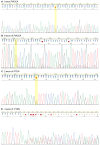Establishment of Novel High-Grade Serous Ovarian Carcinoma Cell Line OVAR79
- PMID: 39769003
- PMCID: PMC11676670
- DOI: 10.3390/ijms252413236
Establishment of Novel High-Grade Serous Ovarian Carcinoma Cell Line OVAR79
Abstract
High-grade serous ovarian carcinoma (HGSOC) remains the most common and deadly form of ovarian cancer. However, available cell lines usually fail to appropriately represent its complex molecular and histological features. To overcome this drawback, we established OVAR79, a new cell line derived from the ascitic fluid of a patient with a diagnosis of HGSOC, which adds a unique set of properties to the study of ovarian cancer. In contrast to the common models, OVAR79 expresses TP53 without the common hotspot mutations and harbors the rare combination of mutations in both PIK3CA and PTEN genes, together with high-grade chromosomal instability with multiple gains and losses. These features, together with the high proliferation rate, ease of cultivation, and exceptional transfection efficiency of OVAR79, make it a readily available and versatile tool for various studies in the laboratory. We extensively characterized its growth, migration, and sensitivity to platinum- and taxane-based treatments in comparison with the commonly used SKOV3 and OVCAR3 ovarian cell lines. In summary, OVAR79 is an excellent addition for basic and translational ovarian cancer research and offers new insights into the biology of HGSOC.
Keywords: cell line; high-grade serous ovarian cancer; ovarian cancer.
Conflict of interest statement
The authors declare no conflicts of interest.
Figures




Similar articles
-
Establishment and Characterization of the Novel High-Grade Serous Ovarian Cancer Cell Line OVPA8.Int J Mol Sci. 2018 Jul 17;19(7):2080. doi: 10.3390/ijms19072080. Int J Mol Sci. 2018. PMID: 30018258 Free PMC article.
-
Molecular characterization of 7 new established cell lines from high grade serous ovarian cancer.Cancer Lett. 2015 Jul 1;362(2):218-28. doi: 10.1016/j.canlet.2015.03.040. Epub 2015 Apr 8. Cancer Lett. 2015. PMID: 25862976
-
CRISPR/Cas9-derived models of ovarian high grade serous carcinoma targeting Brca1, Pten and Nf1, and correlation with platinum sensitivity.Sci Rep. 2017 Dec 4;7(1):16827. doi: 10.1038/s41598-017-17119-1. Sci Rep. 2017. PMID: 29203787 Free PMC article.
-
Complexity of the Genetic Background of Oncogenesis in Ovarian Cancer-Genetic Instability and Clinical Implications.Cells. 2024 Feb 15;13(4):345. doi: 10.3390/cells13040345. Cells. 2024. PMID: 38391958 Free PMC article. Review.
-
Low Grade Serous Ovarian Carcinoma: from the molecular characterization to the best therapeutic strategy.Cancer Treat Rev. 2015 Feb;41(2):136-43. doi: 10.1016/j.ctrv.2014.12.003. Epub 2014 Dec 23. Cancer Treat Rev. 2015. PMID: 25573350 Review.
References
-
- Webb P.M., Jordan S.J. Epidemiology of Epithelial Ovarian Cancer. Best Pract. Res. Clin. Obstet. Gynaecol. 2017;41:3–14. - PubMed
-
- Cancer of the Ovary—Cancer Stat Facts. [(accessed on 25 September 2024)]; Available online: https://seer.cancer.gov/statfacts/html/ovary.html.
MeSH terms
Substances
Grants and funding
LinkOut - more resources
Full Text Sources
Medical
Research Materials
Miscellaneous

